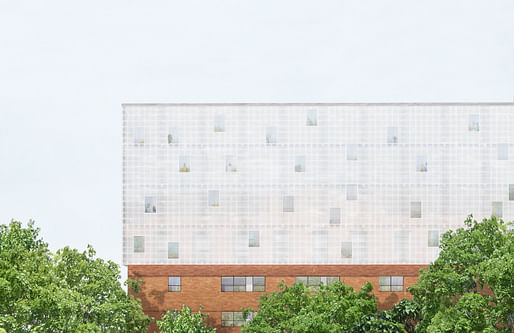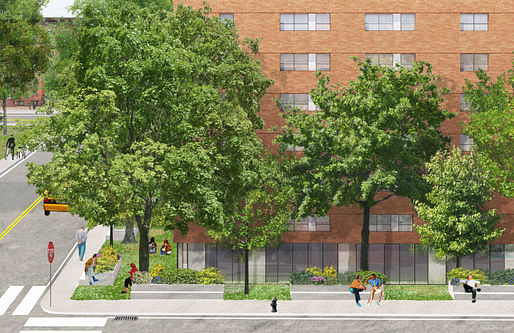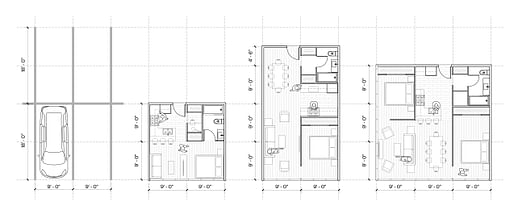
The Regional Plan Association of New York (RPA) has named Miriam Peterson and Nathan Rich of architecture firm Peterson Rich Office (PRO) as the organization’s inaugural Richard Kaplan Chairs for Urban Design.
The year-long research position, funded to “address a critical need for preservation and better design in the New York City region” will position PRO to continue their ongoing efforts to understand and articulate potential solutions for the New York City Housing Authority’s (NYCHA) current capital needs deficit.

According to research already conducted by PRO, NYCHA is currently suffering from $45 billion in unmet capital needs, a byproduct, according to a 2018 RPA report, of “decades of neglect and underinvestment by all levels of government.” That total includes deferred general maintenance and lead abatement issues in individual units as well as building-wide accessibility deficits, weatherizing upgrades, climate retrofitting, and other significant needs.
Over 400,000 people live in NYCHA housing and rely on the organization as a “critical reservoir of deeply affordable housing” in New York City. For comparison, if NYCHA was a separate city, its population would be higher than that of many major American cities, including Buffalo, St. Louis, Tampa, and Pittsburgh.
Despite the relative size of its population, however, NYCHA “has had to absorb ongoing federal cuts since the 1980s, leaving the physical condition of NYCHA housing to steadily deteriorate over the tenures of several mayors and governors and through multiple federal administrations,” according to the report. As a result, today, the organization faces “an unprecedented state of crisis.”

According to RPA, the New York City operating budget allocated just $144 million for NYCHA programs in 2018, a fraction of what it dedicates to libraries, parks, correctional services, and the New York City Police Department. At the same time, the scale of NYCHA’s unmet capital needs has ballooned over the years and now eclipses other significant capital infrastructure projects in terms of projected costs.
Over the years, governance problems at NYCHA have ballooned as well. Earlier this year, Department of Housing and Urban Development Secretary Ben Carson appointed a federal monitor to oversee NYCHA’s operations after finding “systematic failures” there.
One long-term result of chronic underfunding is that NYCHA properties have effectively become “a deteriorating portfolio” particularly susceptible to climate vulnerability, as was the case after Superstorm Sandy, when 33 separate developments were impacted to the tune of $3 billion in damages. As climate change worses, NYCHA’s problems will get worse too: RPA estimates that by 2050, 506 NYCHA buildings will be located within a 100-year floodplain, conditions that will expose one quarter of all NYCHA units to potential flooding.

But, according to PRO, the situation is not all bad. While NYCHA’s assets have the potential of weighing down the organization moving forward, they also represent a potential life raft. During a 2014 study, PRO found that while NYCHA already possesses some 240.9 million square feet of building area over its 324 campuses, many of its properties are under-built overall. PRO discovered that not only do these campuses contain over 20 million square feet of under-utilized surface-level parking lots, but that over 137.5 million square feet of as-of-right floor area has been left unrealized.
That’s a lot of unused space. For example, a pair of 9-by-18-foot parking stalls can easily accommodate a studio apartment in the same area. Add a few more stalls to this arrangement, and suddenly two- and three-bedroom configurations are possible. It is possible that if properly activated through development partnerships, the unrealized buildable area can be utilized to create new affordable housing, alleviate overcrowding, and introduce mixed-income development to the city’s affordable housing stock.

PRO has spent the last several years “focused on the unrealized potential of NYCHA’s assets and how to preserve and improve its vast portfolio.” The designers have worked to find aways to “bring NYCHA into financial solvency, while better integrating NYCHA into the surrounding communities.” Their efforts so far involve generating design proposals that replace surface parking lots with garden apartments, for example, as well as designs that capitalize on unbuilt floor area to cap off existing residential towers with new construction.
Through the new fellowship, PRO will be tasked with synthesizing these ideas into digestible design proposals that “can serve as a template for NYCHA to implement as solutions for improving the financial and physical health of buildings, as well as living conditions for NYCHA’s [residents].”
No Comments
Block this user
Are you sure you want to block this user and hide all related comments throughout the site?
Archinect
This is your first comment on Archinect. Your comment will be visible once approved.